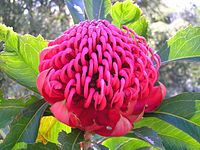
Photo from wikipedia
Analyses of dendrochronological data from 15 recently established tablished stands of pedunculate oak (Quercus robur L.) revealed that functions describing potential tree growth in the absence of neighbours varied more… Click to show full abstract
Analyses of dendrochronological data from 15 recently established tablished stands of pedunculate oak (Quercus robur L.) revealed that functions describing potential tree growth in the absence of neighbours varied more between stands than functions describing competitive effects of conspecific neighbours. This suggests that competition functions can more easily be transferred among stands than potential growth functions. The variability inherent in the natural establishment of tree stands raises the question whether one can find general models for potential growth and competition that hold across stands. We investigated variation in potential growth and competition among recently established stands of Q. robur and tested whether this variation depends on stand structure. We also tested whether competition is symmetric or asymmetric and whether it is density-dependent or size-dependent. Lastly, we examined whether between-year growth variation is synchronous among stands. Potential growth, competition and between-year growth variation were quantified with statistical neighbourhood models. Model parameters were estimated separately for each stand using exhaustive mapping and dendrochronology data. Competition was best described with an asymmetric size-dependent model. Functions describing potential growth varied more among forest stands than competition functions. Parameters determining these functions could not be explained by stand structure. Moreover, annual growth rates showed only moderate synchrony across stands. The substantial between-stand variability in potential growth needs to be considered when assessing the functioning, ecosystem services and management of recently established Q. robur stands. In contrast, the relative constancy of competition functions should facilitate their extrapolation across stands.
Journal Title: Annals of Forest Science
Year Published: 2020
Link to full text (if available)
Share on Social Media: Sign Up to like & get
recommendations!